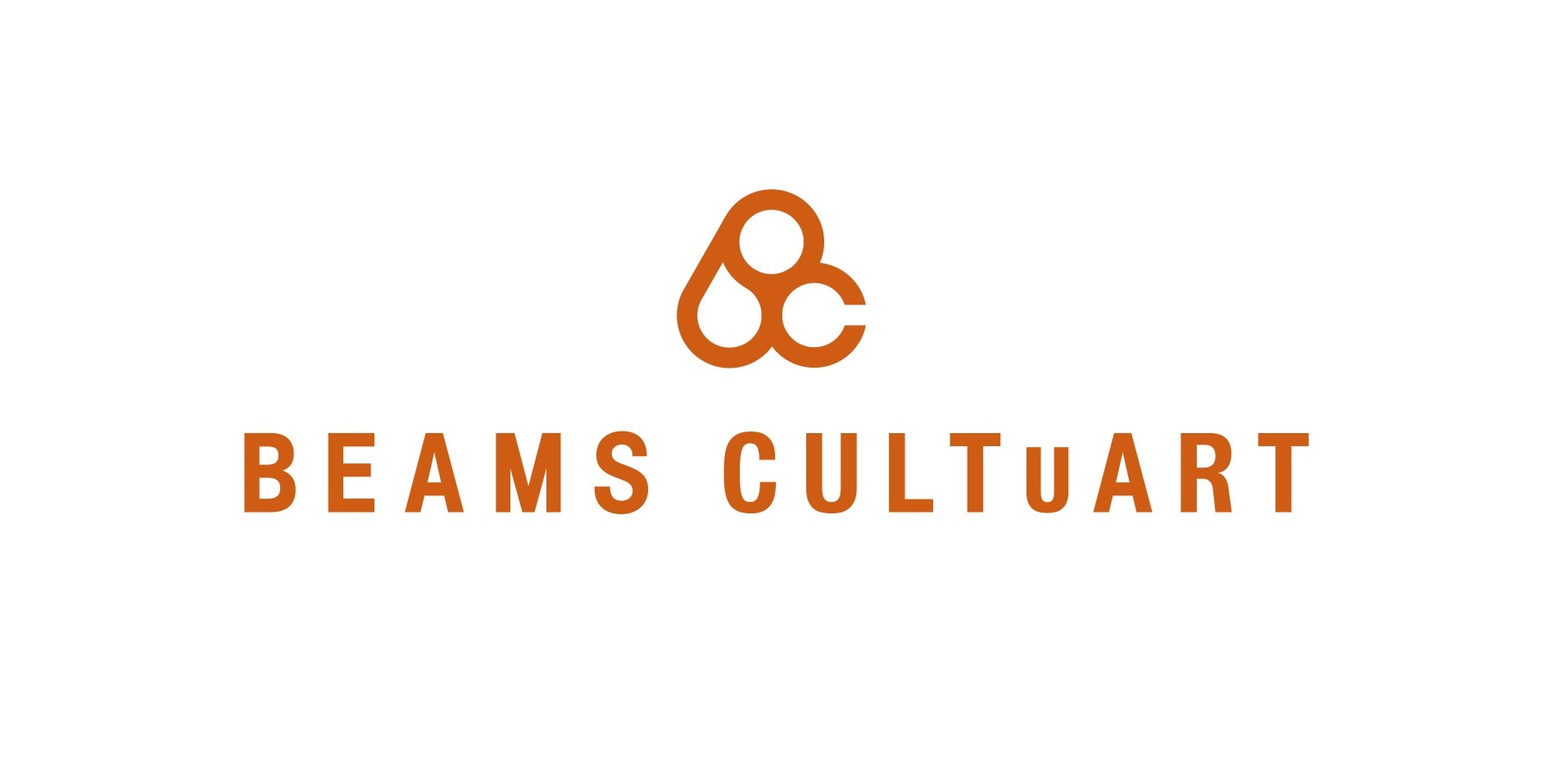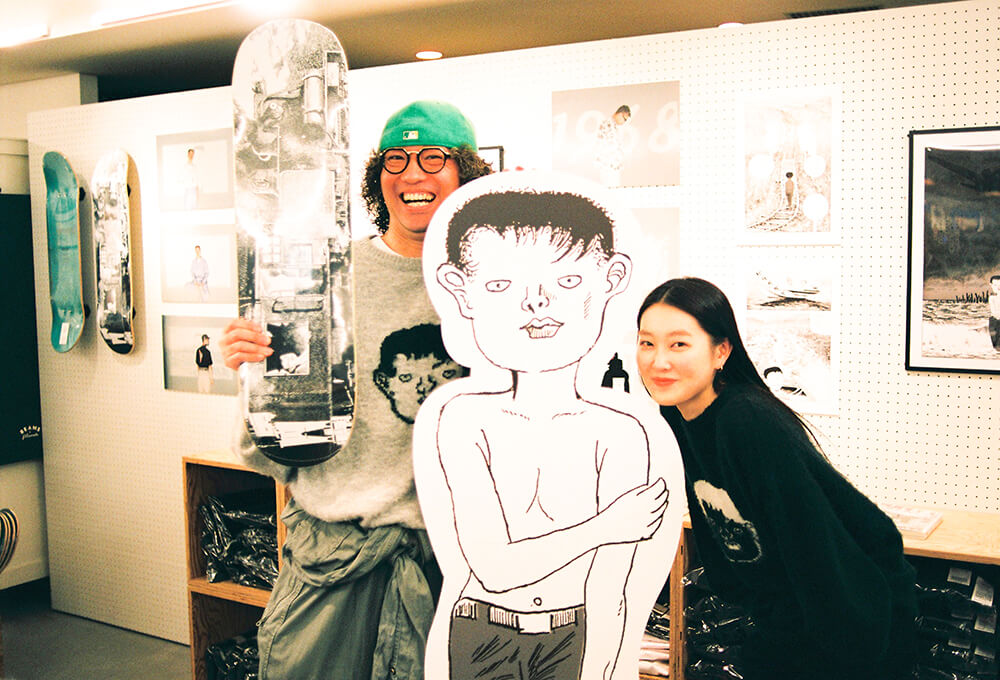

ねじ式が生み出すシナジーのおハナシ。
The Tale of Synergy Crafted by "Neji Shiki"
漫画好きとファッション好きの両方から大きな注目を集めた、漫画家・つげ義春の名作『ねじ式』に焦点をあてたコレクション『NEMES×POWERHOUSE presents 1968』。この発売を記念して「TOKYO CULTUART by BEAMS(トーキョー カルチャート by ビームス)」で行われたポップアップイベントも先日、好評のうちに幕を閉じました。とはいえ、その熱はまだまだ冷めることなく、噂では海外にまで飛び火する可能性も!? そこで改めて、〈ネメス(NEMES)〉ディレクターのZEN-LA-ROCKさんにコラボコレクションについて語っていただこうという寸法です。お相手は、『ねじ式』初体験のモデル・柴田ひかりさん。性別も世代も異なる2人が感じる『ねじ式』の魅力とは。
The collection "NEMES×POWERHOUSE presents 1968," spotlighting the masterpiece "Neji-Shiki" by manga artist Yoshiharu Tsuge, has garnered significant attention from manga enthusiasts and fashion aficionados alike. A popup event celebrating its release recently took place at "TOKYO CULTUART by BEAMS," concluding with resounding success. However, the buzz surrounding it shows no signs of fading, with rumors suggesting a potential overseas expansion! Once again, we delve into the collaborative collection with insights from ZEN-LA-ROCK, the director of NEMES, alongside model Hikari Shibata, experiencing “Neji-Shiki" for the first time. What charms do these two individuals from different genders and generations find in “Neji-Shiki"?
PROFILE

左:ZEN-LA-ROCK
(ラッパー/NEMES ディレクター)
2004年にソロアーティストとしてデビュー。ラッパー、DJ、プロデューサーとして多岐にわたって活動。2010年より自身のブランド〈ネメス〉をスタートさせる。2018年夏には鎮座DOPENESS、G.RINAとのユニット「FNCY」も始動し、楽曲制作、ライブなど精力的に活動を行っている。
Instagram
右:柴田ひかり
(モデル)
独自のファッションセンスとライフスタイルをInstagramやYouTubeをはじめとするSNSで発信し、絶大な人気を誇る。また、モデル活動に加えてフォトグラファーとしての一面も併せ持ち、都内外含め写真展も開催。最近では自身のブランド〈ピープインサイドヘッド(PEEP INSIDE HEAD)〉を手がけるなど幅広く活動中。
Instagram
Youtube
ストリートカルチャーで繋がる2人にとっての、つげ義春とは?
―柴田さんは、 ZEN-LA-ROCK(以下、ゼンラ)さんにどういう印象を抱いていました?
柴田:以前からクラブで見かけていたこともあって、“すごくパーティーな方”という印象があったんです。ただ、先日お仕事でご一緒した際にお話をさせてもらって、沢山自分の好きなモノをお持ちで、しかもそれが本当に好きなのが伝わってきて。なんだか思っていた印象と違うなって。言い方を変えると…オタク気質? といいますか。
ZEN-LA-ROCK:そうそう! まさにソレの極みですよ(笑)。オタクとかサブカルチャー自体が、いまや古い言葉になってしまっているかもだけど、90年代に青春を過ごした俺なんかは、ニッチな存在としてのオタクの最後の世代かもしれない。
―逆にゼンラさんから見た柴田さんの印象は?
ZEN-LA-ROCK:ヒップホップが好きっていうのは聞いていたんだよね。それで別の日に、飲み屋で偶然隣り合った〈バル(bal)〉の蒲谷くんと江田くんから、柴田さんと友達だって聞いて、「おっ、完全にコッチ側のひとじゃん!」って(笑)。
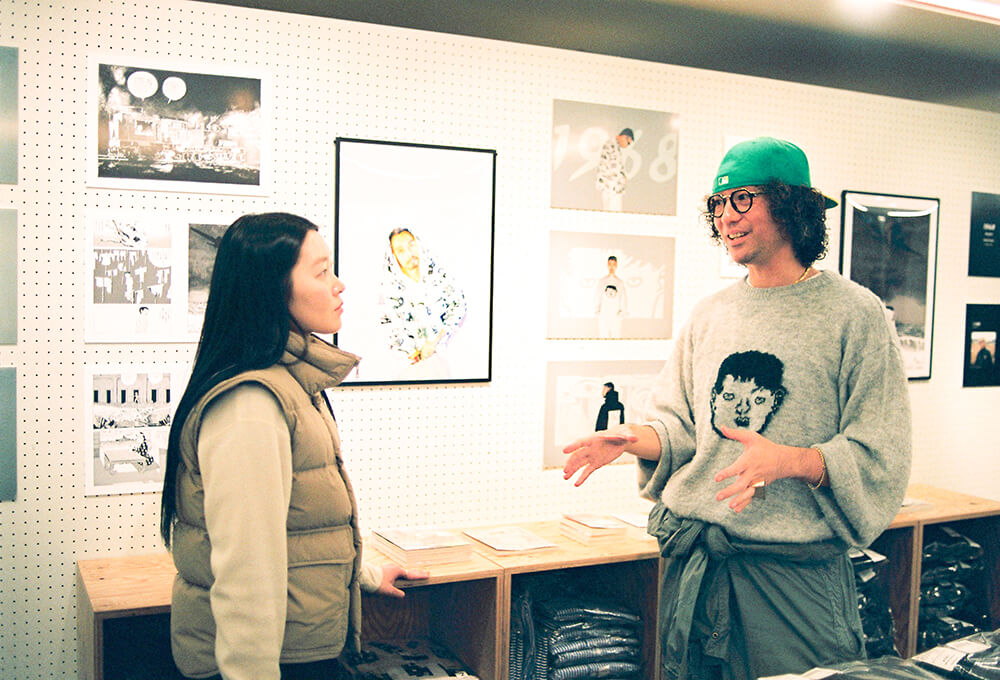
―実はストリートカルチャーの文脈で繋がっていたんですね。ところで柴田さんは、普段から漫画を読まれますか?
柴田:実を言いますと、漫画はまったく通っていなくって…すみません(汗)。
ZEN-LA-ROCK:いやいや~、逆に今回はその方が固定観念なく作品に触れることが出来るからいいのかなと思って、対談のパートナーとしてお声がけさせてもらったんで。そもそも漫画に限らず音楽や映画もそうであるように、誰しも最初は何も知らなくて当たり前。俺自身もそうだったしね。
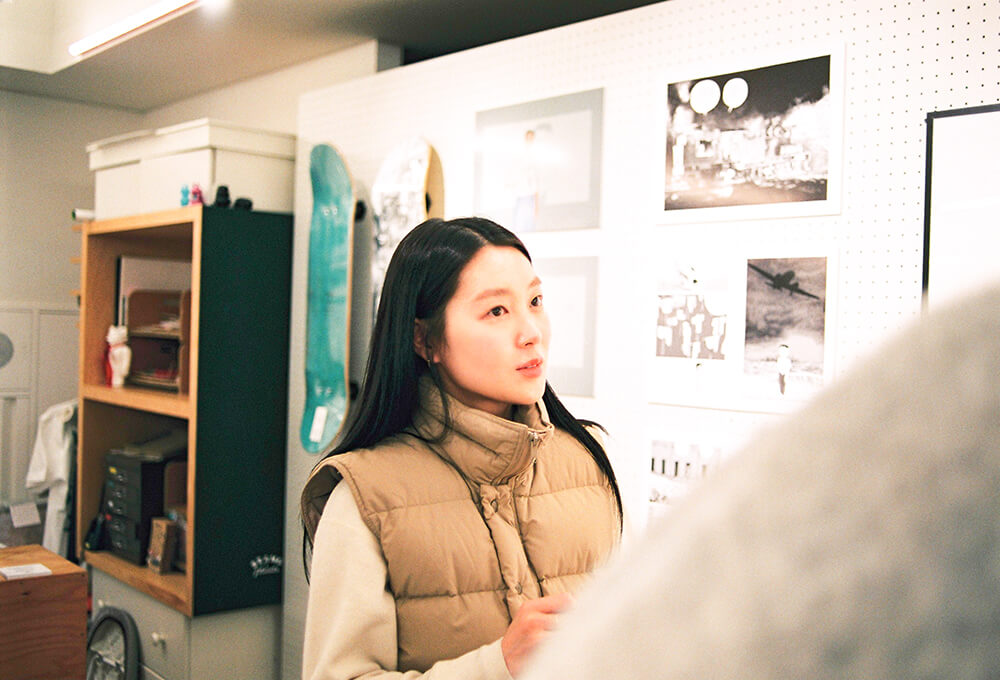
柴田:ありがとうございます。そういう意味では、まさにまっさらな状態です。文庫版のコミックをお借りして『ねじ式』を読んで、そこで初めてつげ義春さんという漫画家に触れたので。
ZEN-LA-ROCK:どちらかといえばクセも強めでマニアックな作品だから、大多数のひとがそんな感じじゃないかな。俺の場合は、実家が古本屋を営んでいたから、幼少期から自然と触れていた作家さんではあるけどね。
―改めて、ゼンラさんから“つげ義春”という漫画家について教えていただけますか?
ZEN-LA-ROCK:昔は…といっても1950年代~60年代とかの話なんだけど、いわゆる貸本漫画っていうカルチャーがあったのよ。戦後の物資難なんかもあって、本屋で漫画本を買うのではなく、貸本屋で借りて読むっていう。そこでレンタル専用の漫画っていうのが生まれたんだよね。
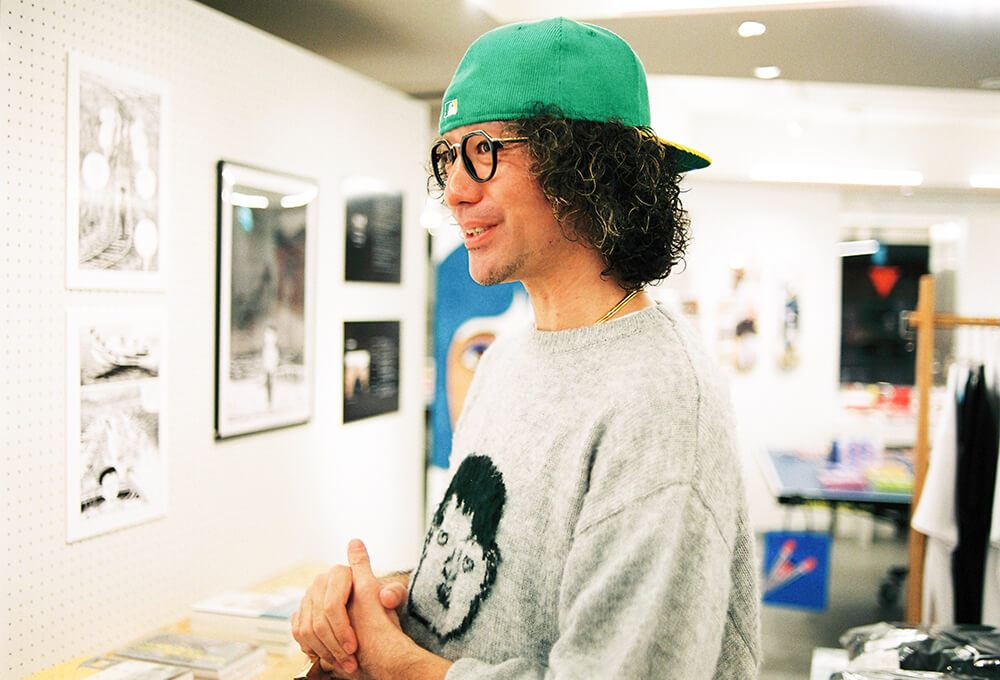
―いまでいうところの、マンガアプリのみで配信される電子漫画的な感じですね。
ZEN-LA-ROCK:若い世代にとっては石器時代みたいな話だよね。「あの頃は、お金がデッカイ石でつくられていてさぁ」みたいな(笑)。
一同:(笑)。
ZEN-LA-ROCK:で、つげ義春さんもその貸本漫画からキャリアをスタートしていて、作品としては日常や夢、旅などをテーマにリアリズムにこだわったものが多いかな。ただ最後に作品を発表した1987年以降の36年間、漫画は1ページも描いていない。しかもあまり人前に出ない方なので、2017年に日本漫画家協会賞の大賞を受賞した際も授賞式はドタキャンしちゃうみたいな。そういった部分も含め、人柄が描いている作品そのものすぎるっていうか。そこがつげ義春という作家の魅力だと、俺は思っています。
世代の異なる両者が思う、感じる『ねじ式』の魅力。
―それでいて海外でも評価が高く、フランスでは“漫画界のゴダール”と紹介されたこともあるとか。柴田さんは『ねじ式』を読んでみてどう感じましたか?
柴田:写実的なタッチからディフィルメされたものまで色んなタッチの絵が混ざっているから、同じ場所・時間軸のはずなのに前後のコマ同士が繋がっているようで、どこかズレているような。その上で予想できない展開が次々と起こりながらテンポよく物語が進んでいき、アッという間に読み終わっちゃう。そういった感覚も新鮮で面白かったです。
ZEN-LA-ROCK:素晴らしい感想!
柴田:私が勝手に想像していた『ねじ式』とは全然違いました(笑)。てっきりネジを中心に話が展開するのかと思って「ねじ式とは何か?」って考えながら読んだんですが、実際はネジが小道具程度の扱いだったりして「え、ねじ式って?」って(笑)。
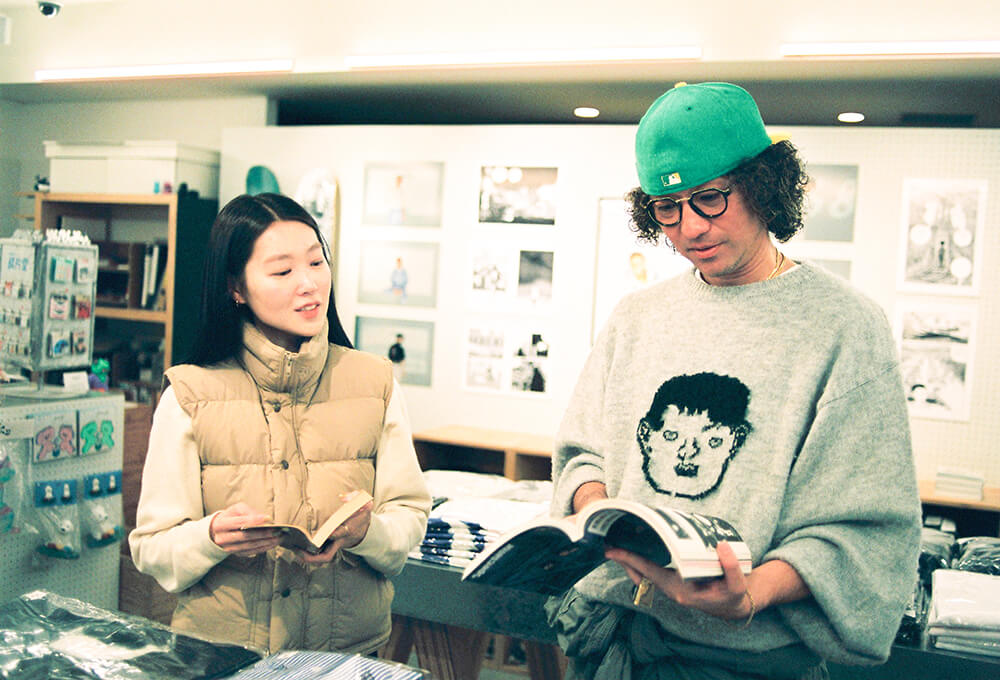
―作中に“ねじ式”というワード自体出てこないですもんね。
柴田:なので「これで合ってるの?」と思いながら読んでいくのも、独特な世界観とすごく合っているなって。ゼンラさんの説明を聞いて、自分の中で『ねじ式』とつげさんがやっと繋がりました。
ZEN-LA-ROCK:なんかもう、全部が変でしょ?
柴田:いい意味で不安というか、ザワッとしたものが残りますよね。
ZEN-LA-ROCK:俺も、彼女に読んでもらったんだけど、「全然意味わかんないし、どちらかといえば気持ち悪かった」って言われて、「そうかもね」って納得しつつも「なんだよ、わかんねーのかよ」ってちょっとムカついたりして(笑)。万人が理解できて好きという作品とはかけ離れているからね、『ねじ式』は。
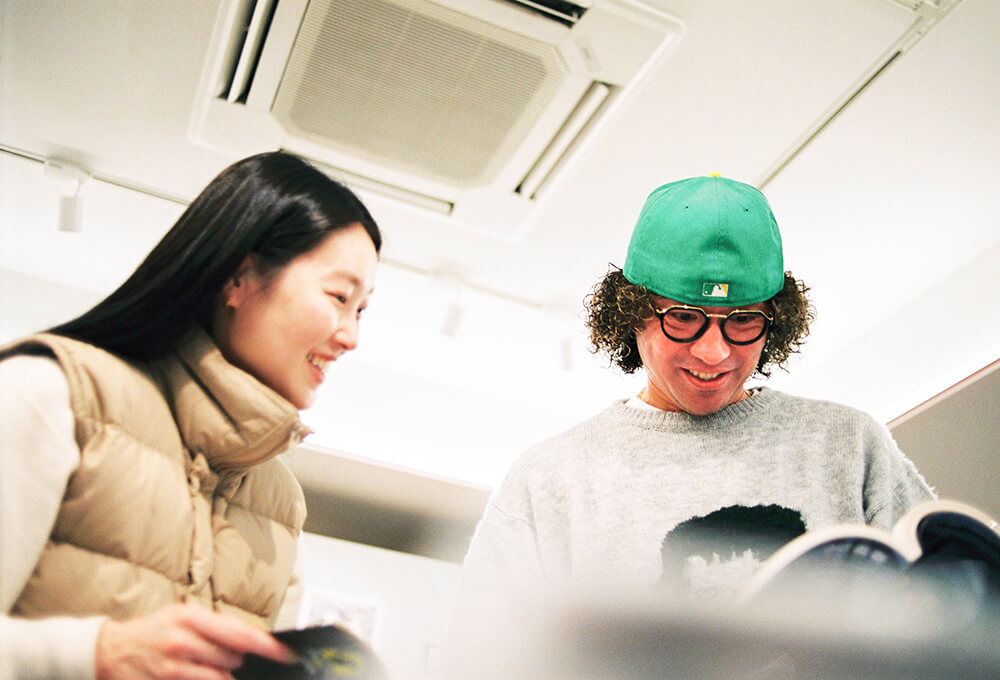
―いまの時代って、漫画にドラマに映画に小説にと、すべてのエンターテイメント作品が“張り巡らされた伏線をいかに回収するか”で評価される中、真逆というか。
ZEN-LA-ROCK:そう、完全に真逆。そういう意味でも、カルト漫画と呼ばれるニッチなジャンルの中でも、出色であり異色な存在。いわゆるクリエイターたちに愛されているのにも、すごく納得がいくなって。俺自身も、最初の出会いがいつだったかも覚えてないくらい、自分の中に刷り込まれているし。
―不条理で不可思議な世界観ですよね。
ZEN-LA-ROCK:夢をテーマにした作品が多いと話したけど、『ねじ式』なんかはまさにそう。ちょっと悪夢的な感じで。
柴田:私の場合、「何かしらの意味が隠されているんじゃないか?」って考えながら読んじゃいました。たとえば「金太郎アメがキーになっている?」とか。もしこの作品に小・中学生の頃に出会っていたら…。
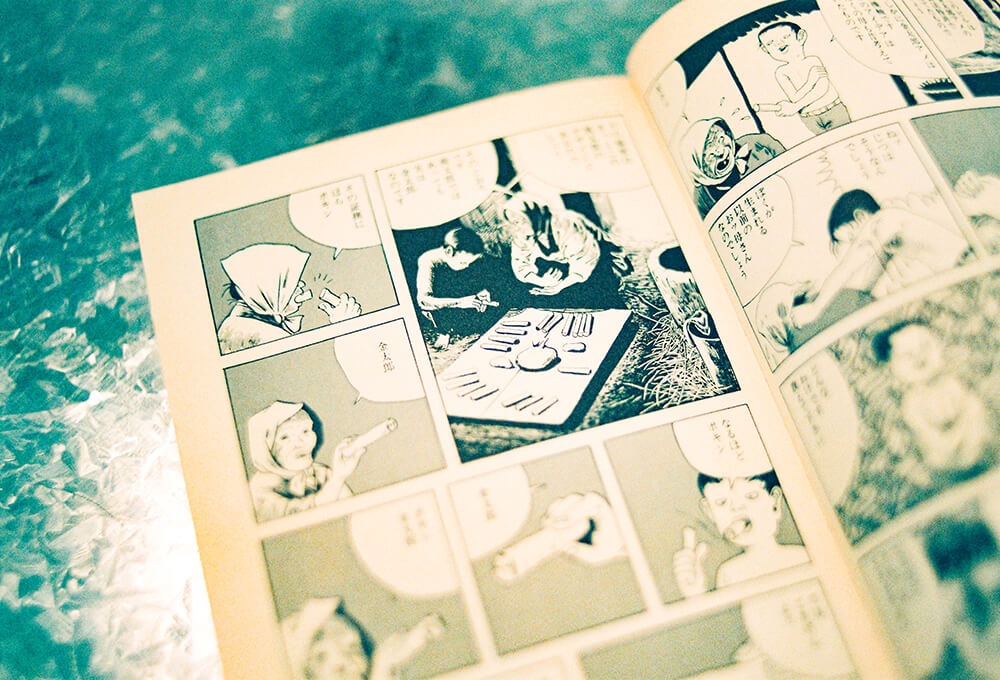
ZEN-LA-ROCK:普通にトラウマもんでしょ。
柴田:ストレートにそう感じるのではなく、裏読みしようとした自分がちょっと悲しかったです(笑)。
―イヤな見方をする大人になっちゃったなぁって(笑)。お二人の好きな場面を教えてください。
ZEN-LA-ROCK:やっぱり、主人公が海から上がってくる1ページ目は印象深いよね。あとは、「ちくしょう 目医者ばかりではないか」のコマとかも。
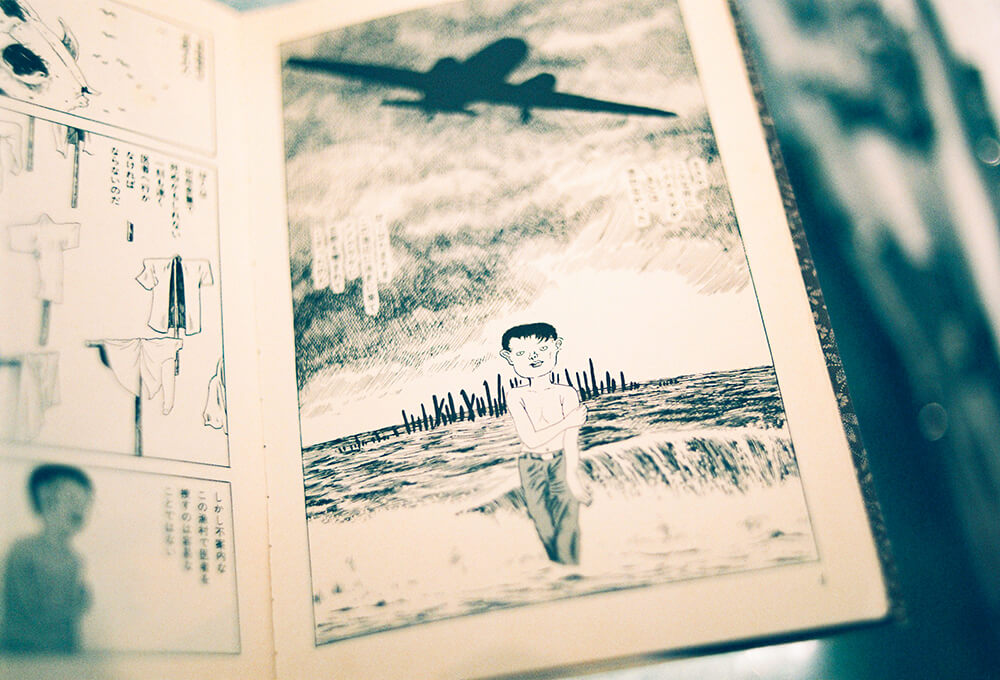
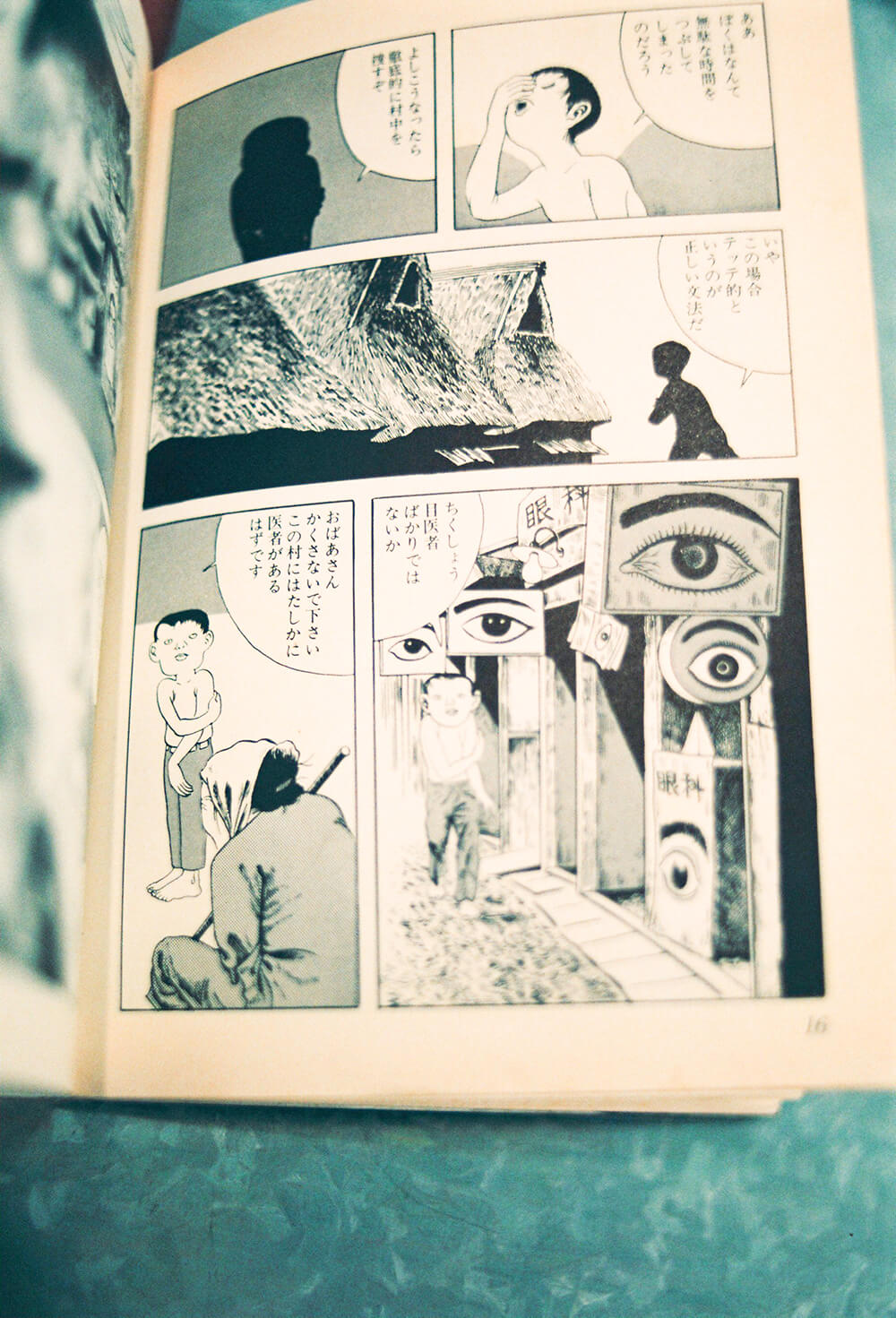
―ネットでもよくネタにされていますよね。この2つのコマは。
ZEN-LA-ROCK:今回持ってきた資料を読んでもらえればわかるように、実はほとんどのコマに元ネタがあるんだよね。2つの写真がコラージュされていたりとか。ヒップホップ的に言うところの“サンプリング”と“ミックス”的な。

柴田:本当だ! たしかにすごく既視感があるコマがあるなって思っていたんですが、木村伊兵衛さんの写真集で見たのかぁ。すごく好きな写真家の作品だったので、「あれ? コレって…」と気になっていたんですよね。
ZEN-LA-ROCK:他のつげ義春作品にもこういったスタイルのものはあまり見当たらないし、55年前にこんな手法で、23ページの作品をつくっていたっていう事実と、掘れば掘るほど深みを増すっていうのも『ねじ式』の魅力。だって、こんな目医者の看板ばかりの場所が実在するとか、すごい話じゃない?
柴田:実際にこういう場所があるってことなんですか?
ZEN-LA-ROCK:いまもその場所があるかは分からないけど、台湾の写真家の作品が元ネタと言われていて、それを見るとまんまこの光景(笑)。
『NEMES×POWERHOUSE presents 1968』についてのよもやま。
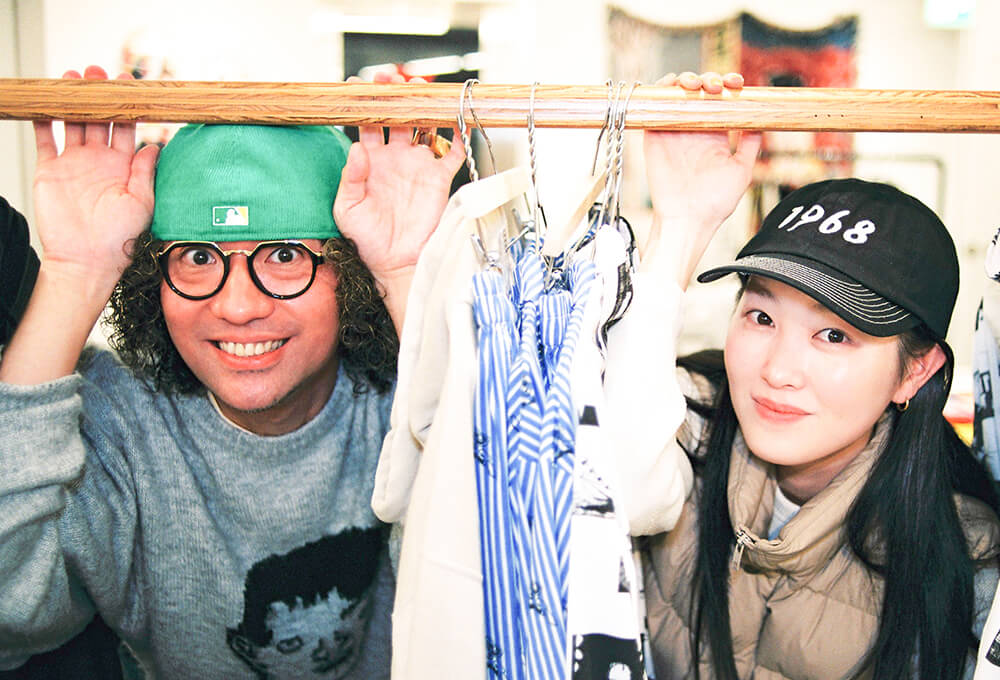
―いよいよ今回の本題。ゼンラさんが手掛ける〈ネメス〉と『ねじ式』のコラボが、どういった経緯でスタートしたのかを教えてください。
ZEN-LA-ROCK:〈ネメス〉のアイテムや「FNCY」のグッズを制作してもらっている友人のプリント工場があるんだけど、そこが〈パワーハウス〉がアートディレクションを担当した『つげ義春大全』のマーチャンダイズのTシャツもつくっていたんだよね。で、それが引越しの荷物整理をしているときにたまたま見つかって。それがきっかけかな。そこから「もし可能なら〈パワーハウス〉とコンタクトを取りたい」と伝えたのが、今年2月の話でした。
―そこからローンチまでに約10ヶ月って、漫画作品とのコラボレーションとしては異例の早さですよね。
ZEN-LA-ROCK:〈パワーハウス〉の入江(祥雄)さんが、3年ほど前に〈ネメス〉でやった『サンクチュアリ』という他の漫画作品とのコラボを知っていてくださっていたのが、大きかったんだと思うなぁ。そこからは『ねじ式』を、どうファッションに落とし込むか問題との戦い。全23ページだから使いたいコマはパッと決まったんだけれども、じゃあ、それをどう見せていくかっていう部分に関しては結構悩みました。
―鎮座DOPENESSさんをモデルに起用したルックも話題になりました。
ZEN-LA-ROCK:俺の中では、鎮さんをモデルに起用するっていうのは、ある種のタブーというか。どのブランドもきっとお願いしたいけど、鎮さんはそんなにモデルをやらなさそうだよね。それを仲のいい身内だからみたいな感じでお願いしちゃうのは、ちょっと違うなと思っていて…。
―チートみたいな。そこからどうやって実現に至ったんですか?
ZEN-LA-ROCK:さて、どうしようかなって悩んだ際に“調布”というキーワードが浮かび上がってきたんだよね。つげさんのお住まいも、鎮さんの地元もともに調布エリア。そこでピタッとハマって。おかげ様でSNS上でも話題になって拡散されたし、鎮さんにまたお世話になっちゃったなぁみたいな(笑)。
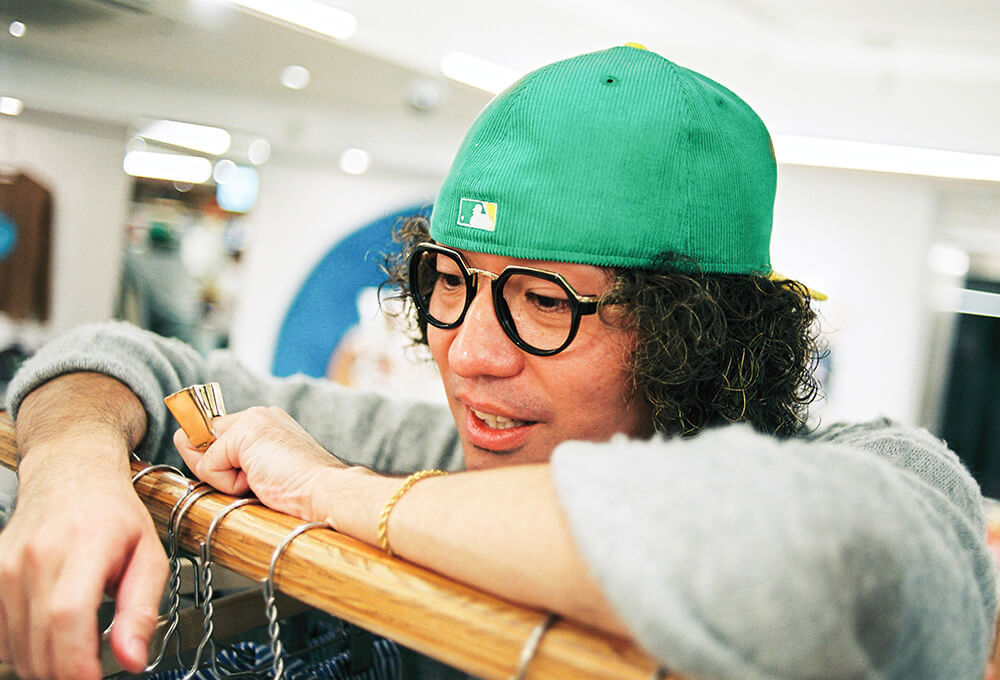
―そもそもの話、漫画好きからしてみたら、つげ義春作品とのコラボって快挙だと思うんです。
ZEN-LA-ROCK:もちろん!「そこってイジっていいのか?」っていう。まさにサンクチュアリ(聖域)的なところだからね。
―その『サンクチュアリ』からの『ねじ式』という流れの意外性もありました。
ZEN-LA-ROCK:実際、そういう反応はスゲェあった。「ちょっと突拍子がなさすぎる」とか。気軽にイジっていい作品ではないし、確実にワァワァ言われるだろうとは覚悟していたし。でも、ディスられるのも認知されている証拠だからね。だけど、いまのところ否定的な声があんまり届いてこないので、逆に「あれれ?」みたいな(笑)。
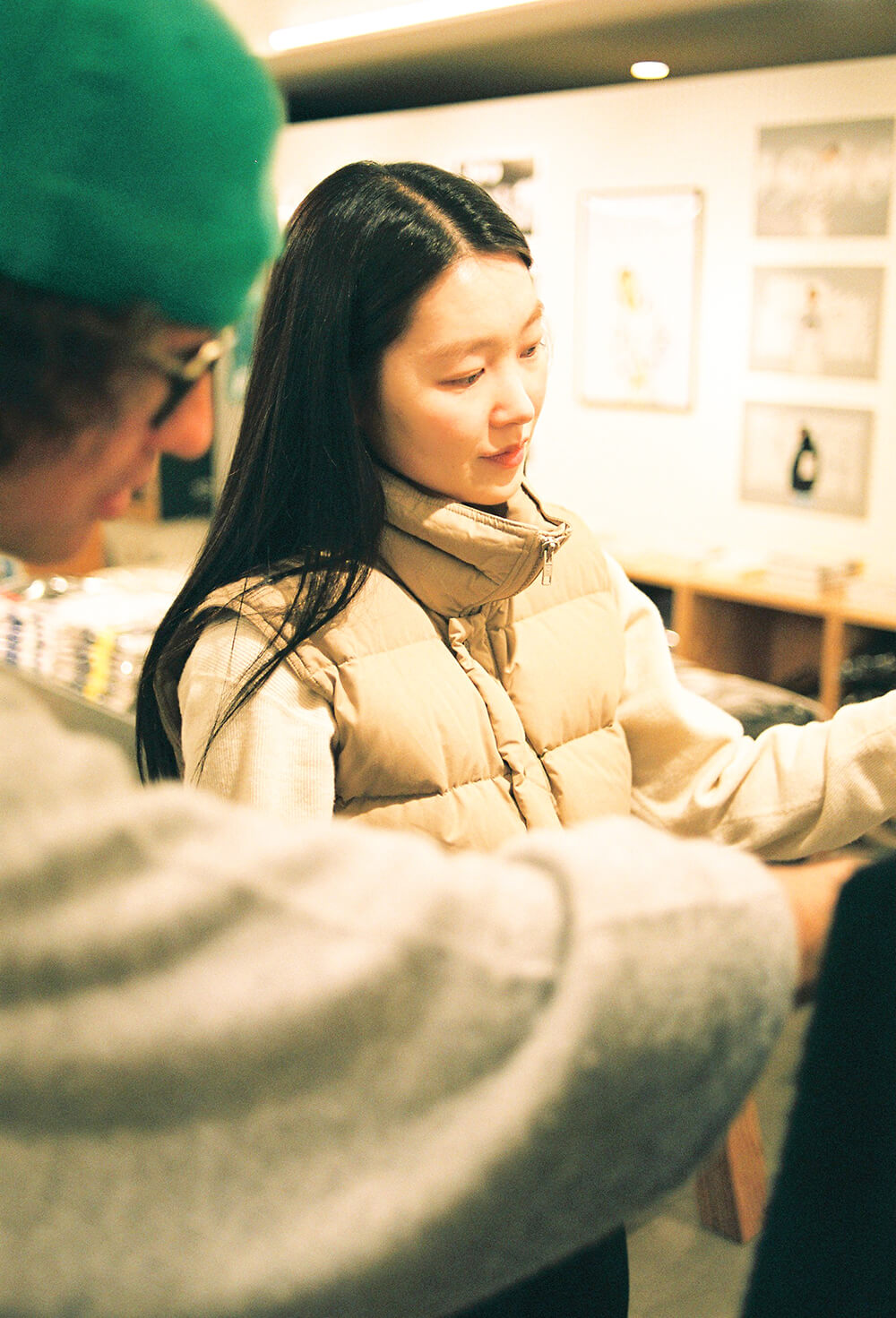
―ご自身も〈ピープ インサイド ヘッド(PEEP INSIDE HEAD)〉を手掛ける柴田さんから見て、今回のコラボコレクションはいかがですか?
柴田:漫画を読んでからアイテムを見ると、ゼンラさんの作品に対する想いがすごく伝わってきて。だからこそ『ねじ式』の世界観と服の両方の良さが、ちゃんと活かされているんだろうなって感じがします。
ZEN-LA-ROCK:嬉しい~アザス! もうそこは、ラブやリスペクトがあるのかどうかって話だよね。ちょっと平易な言葉になっちゃうけど。以前にも、Tシャツやパーカ、手拭いなんかはつくったことがあるみたいで、それらも悪くはないんだけどねぇ~って思いが俺的にはあって。シルエットや素材もだけど、それ以上に気にしたのがプライス。可能な限り値段は据え置きっていうのが、最近の〈ネメス〉のテーマでもあって。
柴田:ニットでこの値段は、かなりのお手頃ですよね。
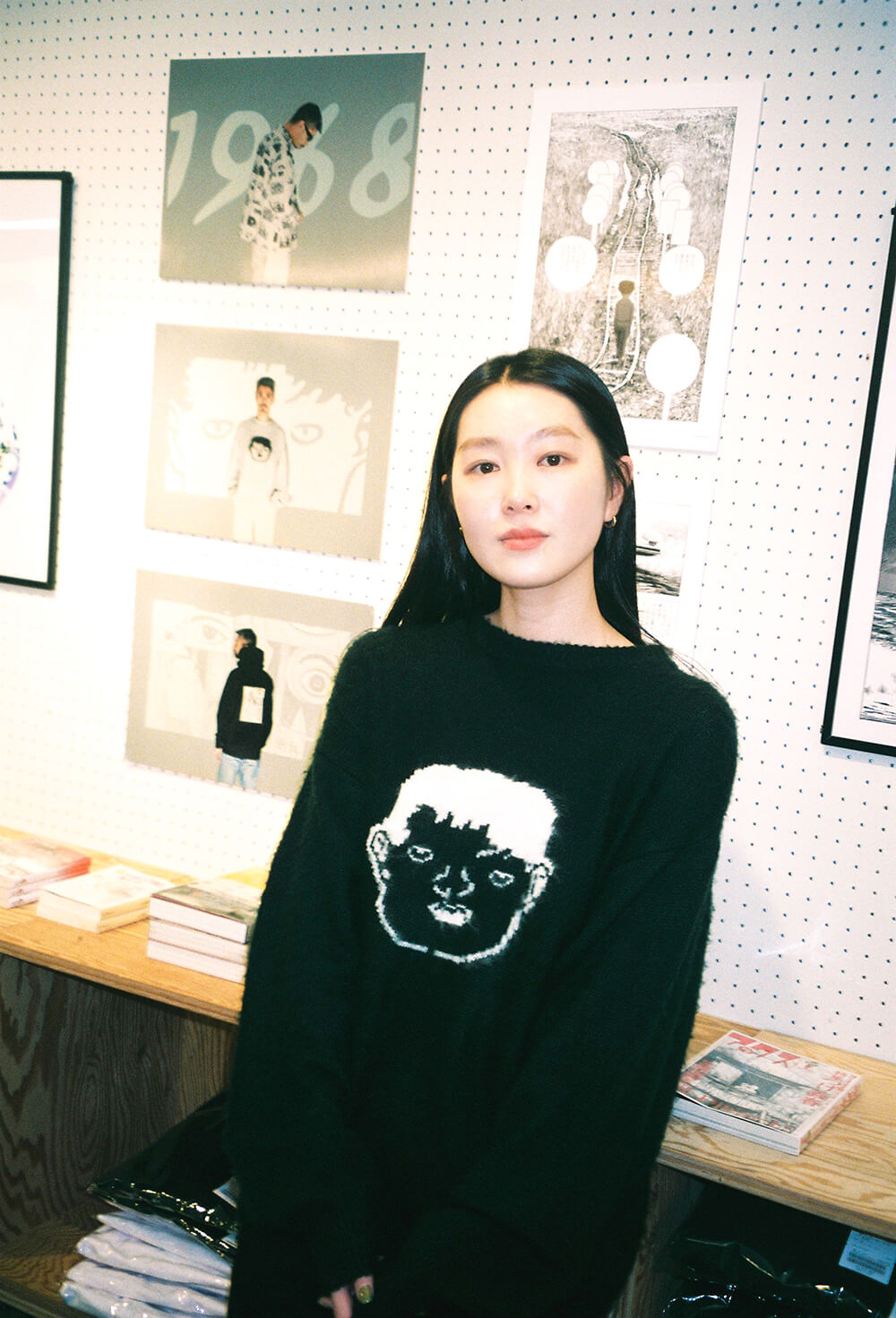
モヘアニット ¥16,280
柴田さんのお気に入りは、ゼンラさんとお揃いのモヘアニット。「着てみると、よりいいなって思いました。着心地も優しくて、“いい意味で”マンガの内容からは想像つかないくらいオシャレで取り入れやすいです」。
ZEN-LA-ROCK:でしょ? ちょっと! いまのところ、太字でお願いします!
一同:(笑)。
―プライス設定に関しては、ファッションクラスタではないお客さんへの配慮ですか?
ZEN-LA-ROCK:どちらかといえば、俺自身があまり高いモノを買わないからっていうのが理由かな。このニットだって2万5000円とかでも本当はいいんだけど、俺的には「間違ってんじゃないの?」とか思っちゃう。「つげ義春を使って金儲けですか?」みたいな。それは本当にダサいよね。なので限界まで頑張らせてもらいました。
―どのアイテムも可愛いですよね。
ZEN-LA-ROCK:特に気合い入れてつくったのが、ニットと総柄シャツとキャップ。あと、パジャマもおすすめ。これを着て『ねじ式』のような夢をみんな見てください♪ なんつって(笑)。
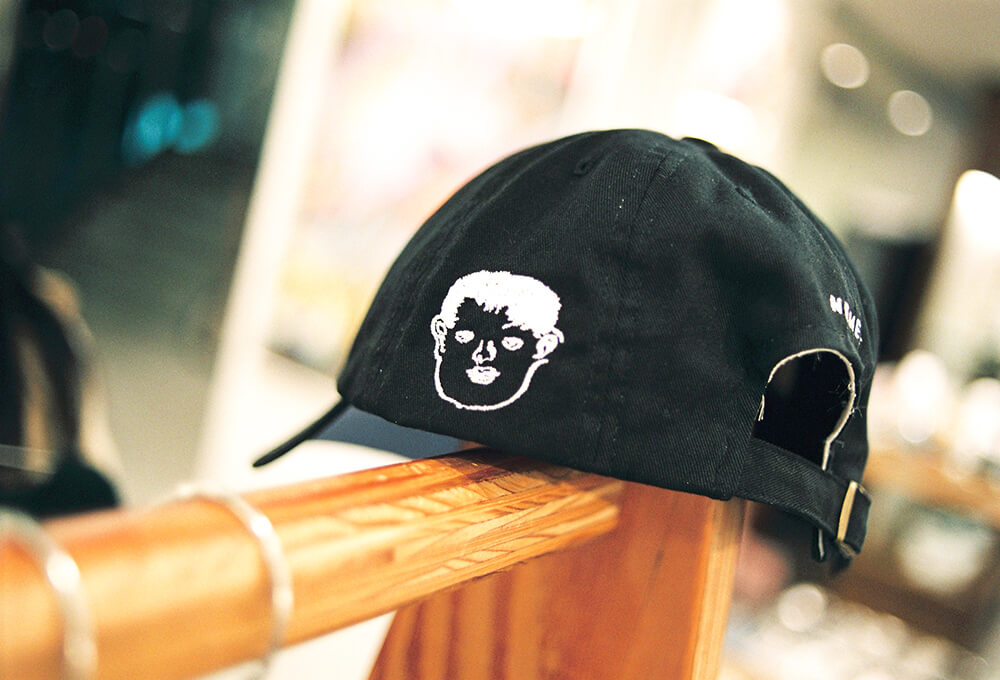
キャップ ¥7,480
『ねじ式』の誕生年である“1968”と主人公を刺繍でオン。ヴィンテージのキャップに見られる8パネル仕様になっているのもポイント。「通常は6枚が主流なんだけど、〈ネメス〉では3年ほど前からこれがスタンダード。まぁ『何か違いがあるの?』と聞かれても特にないんだけれど(笑)」とゼンラさん。
―さっき悪夢的と言っていたような…(苦笑)。これらのグラフィックは、原画をスキャンして制作したんですか?
ZEN-LA-ROCK:さすがに原画を使用するのは難しかったので、『つげ義春大全』のPDFからデータを制作して使っています。基本的につげ先生の線を忠実に活かす方向で進めつつ、ニットのみ、線を太くしたり描き足さないと表現が難しいので若干イジらせてもらって。神様の仕事に手を加えるなんて! と躊躇しながらも、「先生、すみません!」と調布に向かって頭を下げつつ(笑)。
柴田:(笑)。個人的にはキャップがすごく可愛いと思いました。いまはウィメンズファッションでもキャップは定番になっていますし、私の周りでも被っているひとは多いから、作品を知らない方にも喜ばれそう。
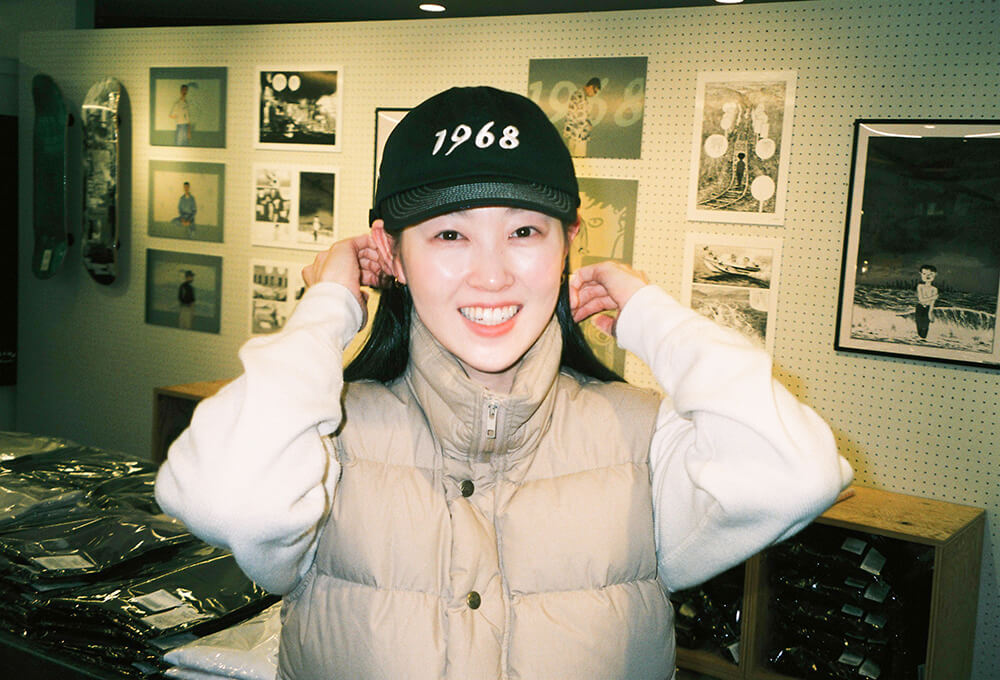
ー柴田さんなら、作品のどこを切り取って服に落とし込みますか?
柴田:やっぱり目医者のコマは使いたくなりますよね。あとは金太郎アメのくだりも結構好き。う~ん、でもファッションとして服に落とし込むなら、目医者なのかなぁ。
ZEN-LA-ROCK:だよね。使いたいコマは沢山あっても、服に落とし込もうとすると、どれも似た感じのデザインになっちゃうから難しくて…。あとは機関車に乗っている少年とかも有名だよね。狐のお面を被ってほっかむりをしているんだけど、鳥山明先生の『Dr.スランプ』にもオマージュしたキャラが登場していたりする。
柴田:へぇ~。
ZEN-LA-ROCK:名前もズバリ、ねじ式くん(笑)。そういった感じで色々な作家からリスペクトされていて、さまざまな作品に影響を与えているっていうのもすごく興味深いよね。
ーそこもヒップホップ的ですね。どのアイテムもクセが強くなりすぎない絶妙な塩梅なので、ミックスして着こなすのも面白そうです。
柴田: 総柄シャツにこのニットをレイヤードして、あえて襟だけ見せるとかもよさそうですよね。もし電車に乗って隣に着ているひとがいたら、ついつい読んじゃいそう(笑)。

ZEN-LA-ROCK:(笑)。擬音だけ残して、人物のセリフ部分は消してあるから、なおさら「何だ、コレ?」ってガン見されちゃうかも。最初は漫画のコマをそのまま使おうと思っていたんだけど、それだとあまり格好良くなくて。とはいっても、これが正解なのか。吉と出るか、凶と出るか…。
柴田:セリフがないほうがスッキリしていいと思いました。ポケットや身頃と袖など切替え部分の柄合わせを、あえてしていないのも、作品の不思議な世界観にマッチしていますし。
ZEN-LA-ROCK:え、本当? 実は柄合わせするとその分コストがかかっちゃうから、しなかっただけなんだけど、どうやら吉と出たか(ニヤリ)。といっても背面は、ガチャガチャして見えないように1枚仕立てにして、全体をちょっとワイドなボックスシルエットに。普通のシャツとは何か違うなって感じにしてみました。
ー若い世代のお客さんにも好評のようで。
ZEN-LA-ROCK:ね! やっぱりサブカルをディグってる若いひとらの中でも、『ねじ式』はマスターピースなんだなって改めて再確認。あとは「TOKYO CULTUART by BEAMS」という場所との相性だったり、鎮さんにモデルをやってもらったことも相まって、全部のピースがカチッとハマったのかもしれないね。
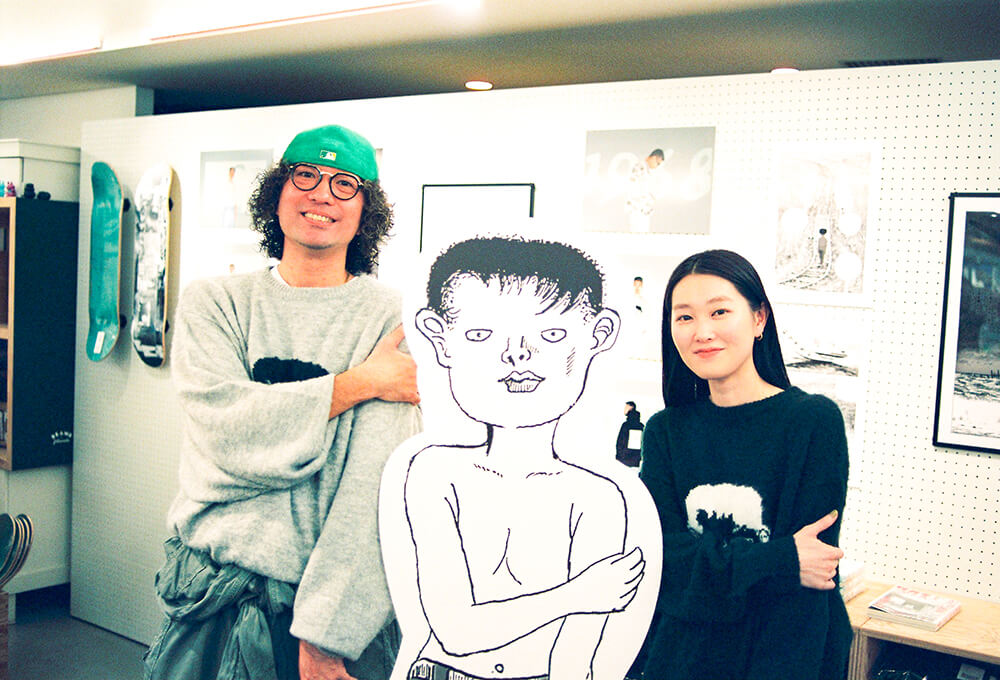
ーゼンラさんはこのコラボコレクションをどのように届けたいと思っていますか?
ZEN-LA-ROCK:つげ義春先生や『ねじ式』のという作品が本当に好きなひとに届けたいし、その上で「ファッションも良いもんだな」って思ってくれたら嬉しいよね。これをきっかけに作品に触れたひとが「すげえ面白かった」と感じてくれたら、それが1番、冥利に尽きるというか熱いっつうか。あと今回の収穫が、親に対してドヤることができたってこと。「お前、すごいなぁ!」なんて言われたりして。ほんと、ありがとうございます!(笑)。
PROFILE

Left: ZEN-LA-ROCK
(Rapper/NEMES Director)
Having debuted as a solo artist in 2004, ZEN-LA-ROCK is active in various roles including rapper, DJ, and
producer. He launched his own brand, NEMES, in 2010. Additionally, he formed the unit “FNCY” with Chinza
DOPENESS and G.RINA in the summer of 2018, engaging in music production and live performances.
Instagram
Right: Hikari Shibata
(Model)
With a significant following on social media platforms such as Instagram and YouTube, Shibata shares her unique fashion sense and lifestyle. Apart from her modeling endeavors, she is also involved in photography, organizing photo exhibitions in and outside Tokyo. Lately, she has been actively engaged in various projects, including her own brand, PEEP INSIDE HEAD.
Instagram
Youtube
Yoshiharu Tsuge’s Influence on Two Individuals Bonded by Street Culture
– What was your impression of ZEN-LA-ROCK (hereafter referred to as Zenla), Shibata-san?
Shibata: I had seen him at clubs before, so I initially thought he was “someone who really loves to party.” However, when I had the chance to chat with him recently during work, I realized he has diverse interests, and his genuine passion for them shines through. It was somewhat different from my initial perception—more like he has a geeky side, you could say.
ZEN-LA-ROCK: Exactly! It’s spot on (laughs). Terms like “geek” or “subculture” might be outdated now, but for someone like me who grew up in the ’90s, I might represent the last generation of geeks, existing in a niche.
– On the other hand, what was your impression of Shibata-san, Zenla?
ZEN-LA-ROCK: I heard she’s into hip-hop. Then, on another occasion, I happened to sit next to Kabaya-kun and Eda-kun from “Bal” at a pub, and when I learned Shibata-san was their friend, I thought, “Ah, she’s definitely one of us!” (laughs).

So, both of you were connected through street culture, weren’t you? By the way, Shibata-san, do you usually read manga?
Shibata: Honestly, I don’t read manga at all… I’m sorry.
ZEN-LA-ROCK: No, no, that’s ok. On the contrary, I thought it might be more interesting, as individuals like you can approach the work without preconceptions. That’s why I invited you to participate in this interview. Just like with music and movies, it’s natural for everyone to start with no knowledge. I was the same way myself.

Shibata: Thank you. In that sense, I truly started from scratch. I borrowed the paperback edition and read “Neji-Shiki,” where I encountered the manga artist Yoshiharu Tsuge for the first time.
ZEN-LA-ROCK: Most ordinary people probably don’t encounter Tsuge like you because his works tend to be quirky and niche. However, in my case, growing up in a family that ran a second-hand bookstore, I naturally came across artists like him from a young age.
Zenla-san, could you tell us more about the manga artist Yoshiharu Tsuge?
ZEN-LA-ROCK: Well, back in the 1950s and 1960s, there was a culture of renting comics. Due to post-war scarcity, instead of buying manga books, people rented them from shops. That’s where the concept of rental-exclusive manga originated.

It’s akin to what we’d call digital manga distributed through manga apps nowadays.
ZEN-LA-ROCK: For younger generations, it’s like talking about the Stone Age. “Back in those days, money was made of big stones, you know?” (laughs)
Everyone: (laughs)
ZEN-LA-ROCK: Tsuge started his career with those rental comics, often focusing on themes like everyday life, dreams, and travel, emphasizing realism. However, since his last work was published in 1987, he hasn’t drawn a single page of manga for 36 years. In addition, he doesn’t appear in public often. Even when he won the Grand Prize at the Japan Cartoonists Association Awards in 2017, he canceled the award ceremony at the last minute.
Including these aspects, his personality is almost inseparable from the works he creates. That, I believe, is the charm of Yoshiharu Tsuge as an artist.
Insights into the Allure of “Neji-Shiki” Across Different Generations
– Even with his last work published in 1987, Yoshiharu Tsuge continues to garner high praise internationally, earning the moniker “Godard of the manga world” in France. Shibata-san, what were your impressions after reading “Neji-Shiki”?
Shibata: The blend of various illustration styles, from realistic to distorted, creates a sense of dissonance within the same setting and timeframe. Unexpected plot twists propel the story forward briskly, leaving you with a fresh and intriguing experience.
ZEN-LA-ROCK: Quite an impression indeed!
Shibata: It was completely different from my expectations (laughs). I anticipated a story revolving around “screws”, given the title “Neji-Shiki,” but instead found screws to be merely incidental props, leading me to wonder, “What’s with the ‘Neji-Shiki’?” (laughs).

– The term “Neji-Shiki” isn’t mentioned in the story, is it?
Shibata: Precisely. This ambiguity aligns perfectly with the unique worldview of the narrative. After hearing Zenla-san’s explanation, “Neji-Shiki” finally clicked with me in relation to Tsuge-san.
ZEN-LA-ROCK: It’s all so bizarre, isn’t it?
Shibata: In a good way, it leaves you with a sense of unease, a restlessness.
ZEN-LA-ROCK: I had my girlfriend read it too, and her reaction was, “I didn’t understand it at all, and it was kind of creepy.” I understood where she was coming from, but I couldn’t help feeling a bit miffed, like, “What? You didn’t get it?” (laughs) Because “Neji-Shiki” isn’t a work for everyone to grasp and appreciate.

ZEN-LA-ROCK: In today’s era, where all entertainment works, be it manga, dramas, movies, novels, are evaluated based on “how skillfully the foreshadowing elements were addressed,” it’s completely the opposite.
ZEN-LA-ROCK: Yes, that’s correct. Even within the niche genre of cult manga, “Neji-Shiki” stands out as outstanding and unique. I can see why it resonates with creators. Personally, I can’t even recall when I first encountered it; it’s just ingrained within me.
– The world view is absurd and mysterious, isn’t it?
ZEN-LA-ROCK: I mentioned that many works have themes related to dreams, but “Neji-Shiki” is exactly that. It has a slightly nightmarish feel to it.
Shibata: Personally, I found myself reading it while pondering if there were hidden meanings behind certain elements. For instance, I wondered if the ‘Kintaro candy’ held some significant symbolism. If I had encountered this manga in elementary or middle school…

ZEN-LA-ROCK: It could be quite traumatizing, couldn’t it?
Shibata: I find it a bit melancholic to delve too deeply into it rather than simply being traumatized (laughs).
– It’s like realizing you’ve become one of those adults who can’t view things straightforwardly, huh (laughs)? Could you both share your favorite scenes?
ZEN-LA-ROCK: Certainly, the scene where the protagonist emerges from the sea is unforgettable. Also, the panel with the line, “Damn it, aren’t they all just eye doctors?” is another favorite.


– These scenes are often discussed online, aren’t they?
ZEN-LA-ROCK: As you’ll see if you read the materials I brought this time, actually, most of the panels have some original reference. Like two photos collaged together, for example. It’s kind of like “sampling” and “mixing” in hip-hop terms.

Shibata: That’s true! I felt a strong sense of déjà vu with some panels, and now that you mention it, I recall seeing them in a photo book by Ihei Kimura. I admire his work, so I was curious, thinking, “Wait, isn’t this…?”
ZEN-LA-ROCK: The use of this style is unique to “Neji-Shiki.” The fact that Tsuge created a 23-page piece using this method 55 years ago makes it even more fascinating. It’s incredible how a place like this, with eye doctors’ signs everywhere, actually exists, isn’t it?
Shibata: Does such a place really exist?
ZEN-LA-ROCK: I’m not certain if it still exists, but it’s said to have been inspired by the work of a Taiwanese photographer. When you see it, it’s exactly like the scene depicted in the manga (laughs).
Interesting facts about ‘NEMES×POWERHOUSE presents 1968’.

– Finally, let’s discuss the main topic. How did the collaboration between Zenla’s “NEMES” and “Neji-Shiki” come about?
ZEN-LA-ROCK: I have a friend who owns a printing factory that produces items for “NEMES” and merchandise for “FNCY.” This factory also produced T-shirts for the “Tsuge Yoshiharu Taizen (complete collection),” which was directed by POWERHOUSE. While sorting through my belongings during a move, I stumbled upon those T-shirts, sparking the idea. From there, I expressed my interest in contacting POWERHOUSE, and that was back in February of this year.
– It’s quite unusual for a collaboration with a manga work to go from inception to launch in about 10 months, isn’t it?
ZEN-LA-ROCK: I think it was significant that Mr. Irie from POWERHOUSE knew about the collaboration between “NEMES” and another manga work called “Sanctuary” about three years ago. That played a big part, I suppose. Then came the struggle of how to incorporate “Neji-Shiki” into fashion. With it being 23 pages in total, it was easy to decide which panels to use, but we had quite a bit of trouble figuring out how to present them.
– The use of Chinza DOPENESS as a model also became a hot topic.
ZEN-LA-ROCK: For me, using Chin-san as a model felt like breaking some sort of taboo. I’m sure every brand would want to ask him, but it doesn’t seem like he’s into modeling that much. So, asking him because we’re close felt a bit different to me…
– Like cheating? How did you manage to make it happen from there?
ZEN-LA-ROCK: Well, when I was pondering over what to do, the keyword “Chofu” came to mind. Tsuge-san’s house and Chin-san’s hometown are both in the Chofu area. It just clicked perfectly. Thanks to that, it went viral on social media, and it felt like I ended up relying on Chin-san again, haha.

– From the perspective of manga enthusiasts, I think collaborating with Tsuge’s works is a remarkable achievement.
ZEN-LA-ROCK: Absolutely! I was like, “Is it really okay?” It’s like stepping into a sanctuary.
– It was also surprising how “Sanctuary” led to “Neji-Shiki”.
ZEN-LA-ROCK: There were indeed strong reactions. People said things like, “It’s a bit too out of the blue.” It’s not something you can casually incorporate, and I was prepared for sure that there would be a lot of criticism. But being criticized is also a sign of acknowledgment. However, so far, we haven’t received much negative feedback, so it’s more like, “Huh?” (laughs).

You have your own brand “Peep Inside Head,” but how do you feel about this collaboration collection?
Shibata: I read the manga, then saw the items, and I could really feel Zenla-san’s passion toward this collaboration. That’s why I believe both the world of ‘Neji-Shiki’ and the quality of the clothing were properly expressed.
ZEN-LA-ROCK: Happy to hear that. Thanks! It might sound a bit cliché, but it really comes down to whether you have love and respect, right? In the past, it seems like there have been T-shirts, hoodies, and towels made around “Neji-Shiki”, and they weren’t bad or anything, but personally, I wanted to focus more on the silhouette and material, and even more on the price. Keeping the price increase as minimal as possible has been a theme for recent NEMES.
Shibata: This price for a sweater is quite reasonable, isn’t it?

Mohair Sweater ¥16,280
Shibata’s favorite is the mohair sweater that Zenla also owns. “When I put it on, I thought it was even better. It’s gentle to wear, surprisingly stylish and easy to incorporate, in a good way, beyond what you’d imagine from the content of the manga.”
ZEN-LA-ROCK: Right? Did you hear that? Bold text, please!
All: (Laughs).
– Is the pricing strategy considerate of customers who are not necessarily fashion enthusiasts?
ZEN-LA-ROCK: If anything, it’s because I personally don’t buy very expensive things. Even though this sweater would be fine at 25,000 yen or so, I’d be like, “Isn’t that wrong?” Or, “Are you trying to make money using Tsuge Yoshiharu?” That’s really lame, isn’t it? So, I pushed it to the limit.
– Every item is cool, isn’t it?
ZEN-LA-ROCK: I especially put a lot of effort into the sweater, the patterned shirt, and the cap. Also, I like the pajamas. Please wear this and have dreams like “Neji-Shiki” everyone♪ Just kidding (laughs).

Cap ¥7,480
Embroidered with “1968,” the birth year of “Neji Shiki,” and the protagonist. It also features an 8-panel design commonly seen in vintage caps. “Normally, 6 panels are the mainstream, but at NEMES, this has been the standard for about three years now. Well, even if you ask, ‘Is there any difference?’ there isn’t one in particular,” says Zenla with a laugh.
– Earlier, you mentioned something about nightmarish…. Were these graphics created by scanning original drawings?
ZEN-LA-ROCK: Using original drawings directly was not possible, so we created data from the PDF of “Yoshiharu Tsuge Taizen” and used it. Basically, while faithfully preserving Tsuge-sensei’s lines, we had to slightly modify them for the sweater, thickening the lines or adding details, as some expressions are difficult. It feels like tampering with the work of God! But while hesitating, I said, “I’m sorry, Sensei!” bowing my head towards Chofu (laughs).
Shibata: (Laughs). Personally, I think the cap is really cool. Caps have become a staple in women’s fashion now, and many people around me wear them, so even those who don’t know the original work might appreciate it.

– Shibata-san, if it were up to you, which part of the work would you pick to incorporate into clothing?
Shibata: I’d definitely want to use the scene with the eye doctor. Also, I quite like the part with the Kintaro candy. Hmm, but if I were to incorporate it into clothing as fashion, maybe the eye doctor.
ZEN-LA-ROCK: Yeah, true. There are many scenes I’d like to use, but when trying to incorporate them into clothing, they all end up with a similar design… It’s difficult. Also, the boy riding the locomotive is quite famous. He wears a fox mask and a hood, and there’s even a character in Akira Toriyama’s “Dr. Slump” who pays homage to him.
Shibata: Oh, I see.
ZEN-LA-ROCK: His name is, of course, “Neji-shiki-kun” (laughs). It’s really interesting how he’s respected by various artists like that and has influenced many works.
– That’s also very hip-hop. Since none of the items are overpowering, it seems fun to mix and match them.
Shibata: Layering this sweater over a patterned shirt and deliberately showing just the collar seems like a good idea too, right? If someone wearing it sat next to you on the train, you’d probably end up reading it and cannot stop (laughs).

ZEN-LA-ROCK: (Laughs). Since only onomatopoeia remains and the character’s dialogue parts are erased, it might make people stare and wonder, “What’s this?” even more. Initially, I thought about using manga panels as they were, but it didn’t look cool enough. But then again, who knows if this is the right answer. Will it bring good luck or bad luck…?
Shibata: I thought it looked cleaner without the dialogue. And not deliberately matching the patterns on the pockets, body, and sleeves adds to the mysterious atmosphere of the work.
ZEN-LA-ROCK: Really? Actually, not matching the patterns saved on costs, but it seems it turned out well (grins). However, for the back, I made it single-layered to avoid looking cluttered and gave the whole piece a slightly wider boxy silhouette. I wanted it to feel different from a regular shirt.
– It seems to be popular among young customers as well.
ZEN-LA-ROCK: Right! Even among young people who dig subculture, “Neji-Shiki” is recognized as a masterpiece. Plus, it might have clicked perfectly with the place like “TOKYO CULTUART by BEAMS,” and having Chin-san as the model, everything fell into place perfectly.

– How do you want to deliver this collaboration collection?
ZEN-LA-ROCK: I want to deliver this collaboration collection to those who truly love the works of Yoshiharu Tsuge and “Neji-Shiki.” I’d be happy if they also thought, “Fashion is pretty cool too.”
On the contrary, if someone who encounters the works of Tsuge for the first time through this and thinks like, “Wow, that was really interesting,” that would be the greatest reward for me. Another thing I gained from this is being able to brag to my parents. They said something like, “Proud of you, son!” So, really, thank you very much! (Laughs).






